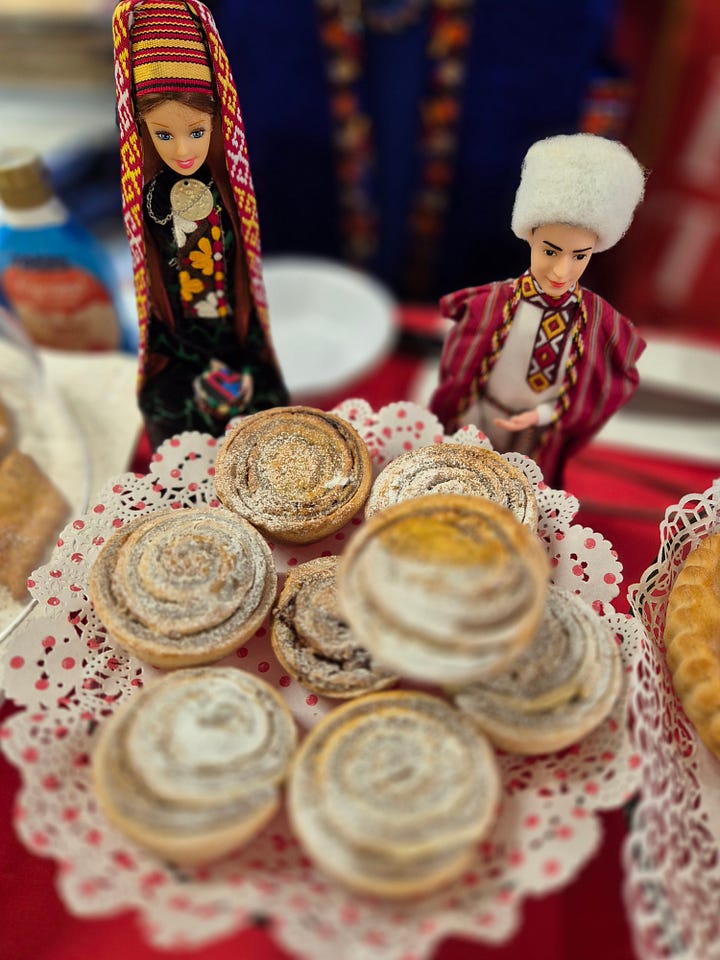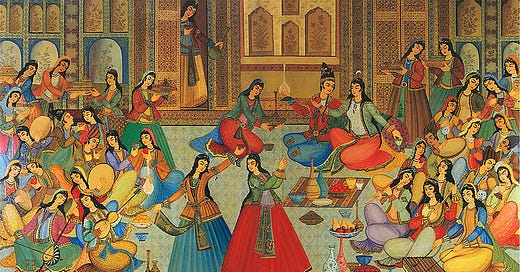Nowruz: Were the Persians right?
A case for moving the Near Year back to spring. Plus: bellydancing and some silliness on London Underground
It’s finally spring!
After months of cold weather and dark nights shivering under my duvet, I’m happy that the sun is shining. Yesterday it was a balmy 17°C — practically sunbathing weather. As we Brits know, the weather can make or break our mood.
You might be wondering why I’m waxing lyrical about spring. I’ll be honest, I never used to be one those people. You know the type: they get misty-eyed and romantic about the change of seasons, and post twee pictures and reels of falling autumn leaves, or cosy cafes serving pumpkin spice lattes.
But spring is when nature beings to arise from its slumber, when birds chirrup louder, and daffodils pop up in gardens.
It’s no wonder that spring is when Persians celebrate Nowruz, which means “new day” in Farsi. The timing of Nowruz aligns with the spring equinox, when day and night are nearly equal in length. That’s thanks to the 11th century Persian polymath Omar Khayyam, who created a calendar so accurate that it’s still used today. In fact, the Jalali calendar is more precise than the Gregorian calendar we use in the West.
Last weekend, at Highgate’s Lauderdale House, scores of visitors packed out the Grade II listed Tudor building, which is hosting a month-long Nowruz celebration.
The atmosphere was jubilant, as what appeared to be the whole of north London’s Iranian community perused the various stalls selling Persian art, handcrafted jewellery (I told myself I wouldn’t buy any but walked away with several pieces), and Farsi literature, as well as homemade jams and biscuits. The cardamom-infused pastry, made by a bubbly woman from Turkmenistan, was moreish.


When I asked the people why Nowruz is marked in spring, they replied as though it were the most obvious answer in the world.
‘In winter everything is so depressing,’ a female stallholder told me. ‘Spring marks a new beginning, the weather is getting warmer, flowers are growing. You can see the change all around you.’
I’m beginning to think she was right and maybe we in the West have got it all wrong. Why on earth do we ring in the new year on January 1st?
Think about it. It’s in the middle of winter, everything is grey, soulless and Christmas already seems like a distant memory. We’re bundled up in layers of warm clothing, nursing colds and coughs. It’s dark when we wake up and dark when we return home from work. And on top of that, we make new year resolutions, promising that we’ll head straight to the gym to get fit and healthy to shed the Christmas pounds when all we feel like doing is indulging in comfort food and hibernating like bears.
Oh I’m sure there are folk out there who like winter (they need studying, if you ask me). But it’s no coincidence that winter causes a form of depression called Seasonal Affective Disorder (SAD). The shorter days, dark nights and reduced sunlight often lead to low energy, changes in sleep and appetite.
If you want to blame anyone for marking the new year in the middle of winter, then look to the Romans. Initially, the Romans celebrated the new year on March 1st, until Julius Caesar changed it to January 1st in 45BC. The Julian calendar remained largely the same until 1582, when Pope Gregory XIII adjusted the calendar to more accurately reflect the amount of time it takes for the Earth to travel around the sun. That’s when January 1st stuck as the beginning of the new year for many. And now it’s effectively the default throughout most of the world.
The Persians, however, refused to abandon the rhythms of nature.
The foundation of Nowruz is attributed to the mythical Persian King Jamshid in the Shahnameh (Book of Kings), an epic poem composed by the poet Ferdowsi in the first century AD.
Jamshid, considered one of the earliest and greatest of the mythical kings of Iran, noticed that during the long, dark winter months, his subjects descended into darkness.
The story goes that one day he ascended to the heavens on a throne studded with jewels. As Jamshid sat on the throne in the sky like the sun shining above, “the world’s creatures gathered in wonder about him and scattered jewels on him and called this day the New Day”.
Today, 300 million people across central and south Asia continue to celebrate with great joy and revelry.

Families, in accordance with tradition, set a table featuring the “seven S’s,” or “haft seen” — sabzeh (wheatgrass), samanu (sweet pudding), senjed (dried fruit), seer (garlic), seeb (apples), somaq (sumac), and serkeh (vinegar) — representing difference facts of life, including health, happines and prosperity.
The house is also given a spring clean (Khane-takani), which aims to wash away the remnants of the past year to make room for positive changes in the upcoming one.
While this is supposed to be a happy time, I’m afraid there are some killjoys out there.
Since the Islamic Revolution in 1979, the clerical regime has been waging a war on Nowruz. However, the Iranian people are having none of it and staunchly resist any such moves.
Just recently a video emerged on social media of Iranian youths defying the mullahs’ warnings, taking to the streets en masse ahead of Nowruz celebrations (they could teach British Gen Zs a thing or two!).
In neighbouring Afghanistan, the Taliban have banned official celebrations of this festival on the grounds that it is pagan and therefore ‘unislamic’. It won’t be long before this lot make it a criminal offence to breathe without their permission.
And it’s just silly. Pretty much all cultures greet the arrival of spring in similar ways. The Hindu festival of Holi, which sees children and adults throwing colour on each other to bring good luck and prosperity, is celebrated on the first full moon of March .
Vaisakhi, the Sikh new year, marks the beginning of the harvest festival in April, and the Chinese New Year in February marks the end of winter. Heck, even the Christian holiday of Easter takes place in spring.
So there you have it. The Romans pushed the world into celebrating the new year in January. But nature has always shown us that spring is when the dark nights come to an end and everything comes to life again. Common sense dictates that maybe we should revert to March for the new year.
This week I recommend…
Moving! Get moving! Look, I get it. When it’s cold and miserable out there, all you want to do is slob on the sofa all day eating comfort food and bingeing on Netflix. And there’s nothing wrong with that from time to time. But our body is not designed to sit all day.
If you’re not a huge gym person and you don’t fancy walking outside in the rain, then why not do a home workout?
I’m a big fan of Leilah Isaac. I’ve followed her YouTube videos for a long time: she’s warm, upbeat, a little bit silly, and teaches at every level, from beginners to advanced. Dancing is not just fun but it counts as exercise!
You can follow her channel here and get hips like Shakira.
What a load of bakwas!
(Bakwas is a great word Urdu/Punjabi word meaning ‘nonsense’. And people, I see a lot of bakwas out there.)
Earlier this month, The Times (£) reported that the books swap shelves at London underground stations might be scrapped. If you use the Tube I’m sure you’ve seen them on your journeys. The idea is simple: commuters can take a book from the shelf and donate one of their own. It’s a great idea and I have picked up several books from Kilburn Station which have gone on top of the growing pile beside my bed.

And yet London Fire Brigade was just just thinking of our physical safety, as it deems them to be “combustible material”. Apparently they’re enforcing regulations that have been in place since 2009.
I’m calling bakwas on this one. Why are newspapers, which are placed just inches away, okay but books aren’t? And if the station is already on fire, I’m pretty sure a few books aren’t going to make much of a difference.
Thanks heavens that London Mayor Sadiq Khan (and I rarely agree with him) stepped in to reinstate them. Various surveys have shown that many adults don’t read on a regular basis, so if a scheme like this can get people to pick up a novel then I’m all for it.
PS. I’m still waiting for the jobsworths at Kilburn to return the bookstand.
That's it from me for this week. Thank you for reading my newsletter. I’m away next week as I’m heading off to Thailand for a much-needed break! Try not to miss me too much.





